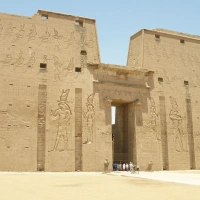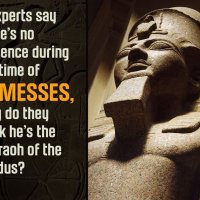An astounding event at the Tower of Babel over 4,000 years ago made language translation necessary today.
The History Book of the Universe records a remarkable series of events. Noah’s family disembarked from the Ark after the Great Flood (Genesis 6:1-9:19) around 2500 BC. God clearly instructed Noah and his sons to “Be fruitful and multiply, and fill the earth.” (Genesis 9:1,7)
Did Noah’s descendants listen to God? No, the clan settled on the plain of Shinar. They made no attempt to spread out and fill the earth. On the contrary, they stuck together to build a Tower, defying God’s order to re-populate the earth. Yahweh therefore confused the language of the Tower builders to force them to scatter across the face of the earth (Genesis 11:1-9).
What Did the Tower of Babel Look Like?
This detailed etching of the Tower of Babel appeared in Athanasius Kircher’s 1679 Latin book Turris Babel. It was drawn by Lieven Cruyl and etched by Coenraet Decker. Notice the artists’ names on the wall in the right foreground. The illustration is replete with tiny interesting details. Click the picture to enlarge it and explore them.
Notice the extensive use of decorative supporting arches all over the massive structure. Encircling the Tower are smoking, igloo-shaped kilns used for firing bricks (Genesis 11:3).
Look at the parade of tiny people and animals, including camels, heading toward the main entrance at the bottom. Notice how the Tower rises above even the clouds. Lower ramps appear as wide as a four-lane highway.
This depiction of the Tower of Babel conveys some sense of how imposing the Tower must have been. The colossal scale of the structure in the etching is consistent with the Biblical description of “a tower whose top will reach into heaven,” a tower that merited God’s attentive inspection, a tower whose fame has persisted globally for four millennia.
Notice the houses built along the upper ramps spiraling up the Tower. Were these penthouses for the ultra-rich? Look at the scaffolding at the top. It indicates that this gigantic structure will soar still further skyward. Behind the Tower on both sides are harbors with numerous sailing ships. Some have dragon heads on their prows!
This imaginative picture gives a vivid impression of how enormous the Tower was compared to everything else. Scattered in the background are towers, pyramids (usually the most imposing structures around), and large municipal complexes. But everything is dwarfed by the Tower of Babel. Even mountains in the distance are dwarfed by the Tower.
The Tower of Babel was a spectacular and impressive architectural feat. It was so huge that it attracted the Creator’s attention in an unprecedented way. God is omniscient; He always sees all things everywhere. Yet to convey how remarkable this project was, Scripture explicitly states, “The Lord came down to see the city and the tower which the sons of men had built” (Genesis 11:5).
Genesis does not say what the Tower of Babel looked like, but archaeological ruins provide clues. Ancient ziggurats or pyramids exist all over the world. Ziggurats are stepped, tiered, or terraced pyramids that usually have a shrine on top. Ruins of these exist in almost 30 different countries including Egypt, Algeria, Nigeria, Sudan, Iraq, Iran, India, China, Indonesia, Cambodia, Greece, Italy, Spain, France, Peru, and Mexico. Why are there so many similar structures spread around the globe?
The Greek historian Herodotus (c. 484–425 BC) reported seeing in Babylon what he believed were the remains of the Tower. According to his description, what was left had eight levels and stood 20 stories high.
The great pyramids of Egypt and the Mayan pyramids in Central America were probably feeble imitations of the original Tower of Babel. Some of the Mayan pyramids were originally much taller than the structures which remain today.
The Great Pyramid of Cholula in southern Mexico is the largest pyramid in the world volume-wise, although it’s not as tall as the Great Pyramid of Giza in Egypt (also called the Pyramid of Khufu or Cheops). See Pyramids of Mesoamerica for photos and information about pyramids in Central and South America.
Both the Egyptian and Mayan pyramids were likely built by people groups who migrated from Babel. Nobody today knows the techniques these ancient peoples used to build these gargantuan structures.
When Yahweh scattered mankind across the earth, many people groups likely took with them sophisticated skills and knowledge of how to build towers. Many undoubtedly rebuilt where they settled.
Herodotus probably saw Etemenanki, the ziggurat that Nebuchadnezzar rebuilt. Etemenanki means “temple of the foundation of heaven and earth” or “house of the platform between heaven and earth”. It’s believed to have been originally constructed around the middle of the second millennium BC.
The geographical range and cultural diversity of these ziggurats and pyramids suggest they were all patterned after an original — the Tower of Babel. The inspiration for the stepped pyramids that cultures built all over the world was the basic memory of the original Tower of Babel. They preserved their memories of the Tower in architecture, whereas the Hebrews preserved theirs in written documents. These towers also re-enacted the rebellious drive to try reaching heaven physically, with an enormous building, rather than approaching God spiritually, seeking inner righteousness as He commands.
Working backwards from the apparent copies to the original, it’s reasonable to think that the Tower of Babel was built on a rectangular base with successive levels of receding tiers. Even though most artistic renderings of the Tower represent it as round, that is unlikely. It’s more difficult to build a round tower than a square one.
No one knows how tall the Tower of Babel was. The builders’ stated plan was to build “a tower whose top will reach into heaven.” (Genesis 11:4) It was extraordinarily tall and imposing–so phenomenal that the Almighty wanted to take a personal look at it (Genesis 11:5)–but Genesis does not record its precise height.
The Book of Jubilees, part of the Old Testament Apocrypha, describes the Tower as having a rectangular base 7,800 ft by 18,000 ft (via conversion, 1 stade = 600 ft, per Herodotus). It says the height was 8,150 ft (via conversion, 1 cubit – 1.5 ft).
(See The Book of Jubilees, chapter 10, vs 19-27, R.H. Charles translation)
This sounds fantastically immense — it’s certainly impossible with today’s technology. But we usually underestimate ancient man. He was smarter, stronger, and probably bigger than men today. Less genetic deterioration had accumulated in these men than in men today. Moreover, the tower builders at Babel still possessed much of the vigor of early man. For example, the average lifespan of the patriarchs from Shem to Peleg was 435 years. These patriarchs were contemporary with those who built the Tower of Babel. So maybe Jubilees is correct. I don’t dismiss it just because it’s beyond today’s capabilities.
The Tower of Babel was a mammoth edifice. It was the site of a pivotal event of world history. Its consequences cascade down through the centuries to our own day. Have you ever struggled to learn another language, or to understand someone with a heavy foreign accent? Have you ever felt confused or bewildered in a place with an unfamiliar language? You can credit your rebellious ancestors at the Tower of Babel for causing your troubles.
Soli Deo Gloria.
This is the third post in the Tower of Babel series.
Read the prequels:
1. Tower of Babel & Language Translation
2. Tower of Babel – Where?
Subsequent posts will suggest answers to intriguing questions about the Tower of Babel:
When did the event occur?
What was the common language at Babel?
How many languages did Yahweh create at Babel?
How is Babel a major problem for evolutionists?
Read the sequel:
4. Tower of Babel – When?
The Translation Page which prompted this series offers automatic translations of the Bible-Science Guy Blog into over 60 languages!
Subscribe – Don’t miss future blog posts!
Click the sidebar’s “SUBSCRIBE” button to follow the
Bible-Science Guy Blog. You’ll automatically receive
new posts free by email. Click SUBSCRIBE NOW!
©William T. Pelletier, Ph.D.
“contending earnestly for the faith”
“destroying speculations against the knowledge of God”
(Jude 1:3; 2 Cor 10:4)
Wednesday March 20, 2013 A.D.
Now the whole earth used the same language and the same words. And it came about as they journeyed east, that they found a plain in the land of Shinar and settled there. And they said to one another, “Come, let us make bricks and burn them thoroughly.” And they used brick for stone, and they used tar for mortar. And they said, “Come, let us build for ourselves a city, and a tower whose top will reach into heaven, and let us make for ourselves a name; lest we be scattered abroad over the face of the whole earth.” And the LORD came down to see the city and the tower which the sons of men had built. And the LORD said, “Behold, they are one people, and they all have the same language. And this is what they began to do, and now nothing which they purpose to do will be impossible for them. “Come, let Us go down and there confuse their language, that they may not understand one another’s speech.” So the LORD scattered them abroad from there over the face of the whole earth; and they stopped building the city. Therefore its name was called Babel, because there the LORD confused the language of the whole earth; and from there the LORD scattered them abroad over the face of the whole earth. (Genesis 11:1-9)
































Thanks, BSG. Your penetrating investigations always dig up new details and give us much to ponder!
Recently went to The Henry Ford Museum where they displayed scale models of the tallest buildings in the world today all constructed of LEGOS! The Burj Khalifa in Dubai being the tallest (actual height 2,722 ft.). The model reached from floor to a much higher than average ceiling.
All I could think of was the Tower of Babel and that mankind is still at “making a name for himself”!
LikeLike
By: Kelly on March 23, 2013
at 10:41 am
Thank you for your articles on the Tower. I plan on linking all of them into my Bible lesson this week. Thank you and I look forward to following you and reading your future content. 🙂
LikeLike
By: future.flying.saucers on October 9, 2013
at 3:56 pm
Well the WORLD trade center were called towers weren’t they, once the tallest buildings in the world. It reminds me of the towers of Babel with the different languages, and the different races.
LikeLike
By: Winni on January 10, 2014
at 5:42 am
I think one of wrong assumptions is that the tower was completed. I think the story is clear that God intervened to stop it… so it is not possible to know how far they got.
LikeLike
By: ddevonb on December 28, 2015
at 1:55 pm
Thanks for reading and commenting. Today no one knows how much of the tower or city was completed or what either looked like. The city was not completed because Genesis 11:8 says, “they stopped building the city.” But we don’t know whether the tower was completed or not. Genesis 11:5 cites “the tower which the sons of men had built,” so it’s possible the tower was finished when the Lord inspected it.
LikeLike
By: BibleScienceGuy on January 3, 2016
at 12:49 pm
Very informative; sharing this with artful Bible class
LikeLike
By: Geraldine M. Bonds on January 14, 2016
at 6:20 pm
Thanks for reading and sharing and for your encouraging words.
LikeLike
By: BibleScienceGuy on January 15, 2016
at 11:18 pm